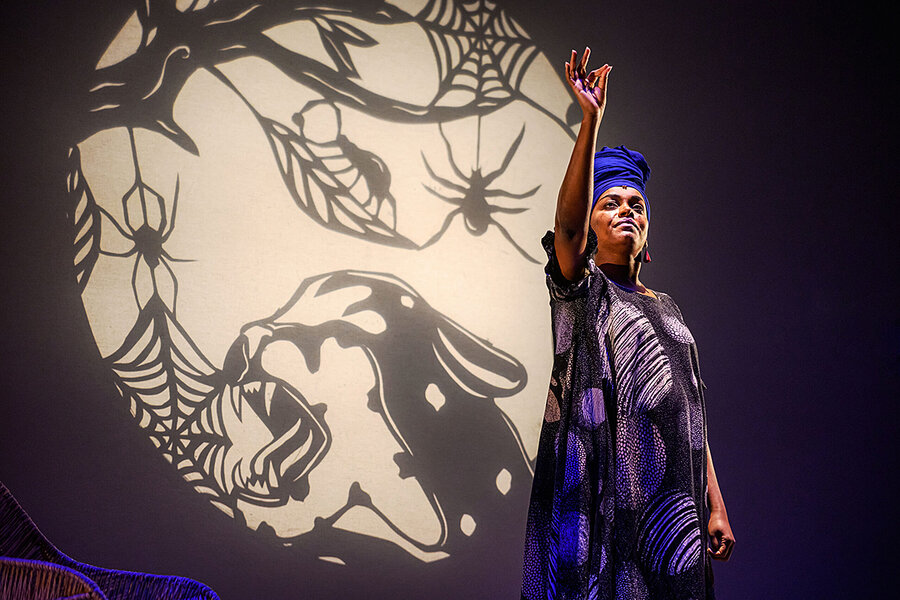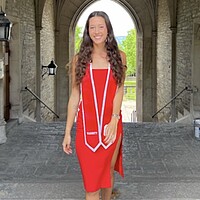‘The Book of Life’: How one artist creates healing out of tragedy
Loading...
How can a nation heal from unspeakable tragedy? For Odile Gakire Katese, or “Kiki,” as she’s known, celebrating life must take precedence over death. Ms. Katese, a Rwandan playwright, performer, and director, uses her talents to create a different legacy around the 1994 Rwanda genocide in “The Book of Life.”
The show features a collection of letters written by the living to the dead and a spider fable told with cutout projections. Throughout, the drummers of Ingoma Nshya – Rwanda’s first all-female percussion group founded by Ms. Katese in 2004 – provide accompaniment. “If we keep telling the stories of killings and blood and crimes, if this is the only thing we do, we can be stuck in those places,” Ms. Katese says in an interview.
Why We Wrote This
A story focused onAfter being gripped by horror on a mass scale, how does a country find hope for the future? One Rwandan artist wants to leave a legacy for the next generation that focuses on life rather than death.
The show, which premiered in Toronto, made its United States debut in June at the Spoleto Festival USA in Charleston, South Carolina. It starts a run in Boston Oct. 18.
“As a mother, I knew that I didn’t want to translate stories of death to my children. And so it was important to find a way to remember, in another way, to really remember people,” says Ms. Katese. “We had to talk more about what brings us together, than what separates us.”
How can a nation heal from unspeakable tragedy? For Odile Gakire Katese, or “Kiki,” as she’s known, celebrating life must take precedence over the details of death. Ms. Katese is a Rwandan playwright, performer, director, and cultural entrepreneur. She uses her talents to create a different legacy around the 1994 Rwanda genocide, in which more than 800,000 people are estimated to have been murdered, in her work, “The Book of Life.”
Instead of focusing on the horror, Ms. Katese, who grew up in exile with her family in the Democratic Republic of Congo, makes retelling the life stories of those who have been lost the centerpiece of her performance. “The Book of Life” features a collection of letters written by the living to the dead and a spider fable told with cut-out projections. Throughout, the drummers of Ingoma Nshya – Rwanda’s first all-female percussion group, founded by Ms. Katese in 2004 – provide accompaniment.
“The Book of Life,” which premiered in Toronto in 2019, made its debut in the United States this June in Charleston, South Carolina, at Spoleto Festival USA. The show starts a run in Boston on Oct. 18.
Why We Wrote This
A story focused onAfter being gripped by horror on a mass scale, how does a country find hope for the future? One Rwandan artist wants to leave a legacy for the next generation that focuses on life rather than death.
Ms. Katese recently spoke with the Monitor via Zoom about her creative process, hope, and how to heal. The interview has been edited and condensed for clarity.
I’d love to hear more about the creation and production of “The Book of Life.”
I started the project in 2009 for the 15th commemoration of the 1994 genocide against the Tutsi. ... [I]n 2004, I worked on another show on the commemoration of the genocide. ... I collected testimonies and built a play about that that toured in schools and villages, even in prisons. But I was realizing that I was causing trauma everywhere I was going with the testimonies about what happened in the 100 days of the genocide. ... And I remember deciding that I had to find another way.
How did you decide to frame letters in this project, and how did you go about collecting other people’s stories?
My parents were in exile when they had all their children. I came back to Rwanda when I was 20, not speaking the language of the country, not knowing the story, and not necessarily knowing the people that were lost. So I realized that I had lost a big part of my family. ... And also, as a mother, I knew that I didn’t want to translate stories of death to my children. And so it was important to find a way to remember, in another way, to really remember people. That means you first meet them. We come to know who they were, and that’s why the letters were important, because also at that time, Rwanda was rewriting the history of Rwanda because it was full of the seeds of division and hatred – and that was written by the colonials – and in order to end this cycle of violence, we had to talk more about what brings us together, than what separates us. ...
In Rwanda, we have over 200 small memorial sites all over the country. ... But I had the feeling every time I visited the memorial sites that we archive death, we archive our failures, and this is the legacy [passed on] to the next generation. But I want, yes, to confess to the next generation that we failed in 1994, but we tried to undo that in some ways. And the letters [are] one of the ways to try to undo what we did, because if we kill the people in 1994, we can bring them back to life through the letters.
In the process of healing, why is hope so important?
Because otherwise you lie down and die. So it is important to stay alive, because after death there is life. And life, life is about hope. It is about faith. ... For me, the bridge between life and death is something that gives strength and power and hope for the future because you didn’t lose [the victims of the genocide]. You still have a space where you can still find them and go meet them and carry them through your life. It is important that they stay alive, not necessarily in our hearts ... but in [our] daily lives, in books, in songs. Their stories have to be told so that we don’t forget. If we forget, they vanish. And this is the worst scenario.
People are capable of both destruction and unity. So how did you grapple with this when you created “The Book of Life”?
I mean, we failed in 1994, but we are also capable of doing good things and we need to be given those opportunities so that there is a balance. But if we keep telling the stories of killings and blood and crimes, if this is the only thing we do, we can be stuck in those places ... and then it also affects our relationship with the perpetrators and it’s going to fuel the cycle of violence. We have to find the balance there and forgive ourselves –it’s not forgiving the perpetrators only – so that we allow ourselves to emerge from that. ... So it is important to also feel that hope, that vision, and remind people that yes, we are capable of the best and the worst, and now it is important to work to undo what we did in some way.
How can grief create a collective?
I think this is what happened with the drummers. We are all from a different side of the genocide. We are orphans, widows, children of perpetrators or wives of perpetrators. And we came together because the genocide has affected all of us. Not only the survivors, [but] the perpetrators also. ... We are living in the same country that was destroyed. We have the same challenges. We all need a place to gather, to live together, because loneliness is not a good thing for anyone. So that pain can be an opportunity to transform you and can be an opportunity to bring people together if they want that – it is important that they want that – and give ourselves a second chance to rebuild. ... So, somehow the genocide also brought the people together and forced them to live together, to make the right choices. And it has been quite a miracle that Rwanda was able to grow together again after the genocide.
What are you hoping audiences take away from the performance?
I think it is literally said in that myth of the grandmother spider bringing the sun [featured in the performance], that out of darkness, there is light. As simple as that.
And maybe to think also again about the way we remember or we don’t remember. But remembering means also making the choice of forgetting something ... and the thing we choose to remember helps us to become better people or to live together. But it means that somehow you have to forget the things that still divide you.









